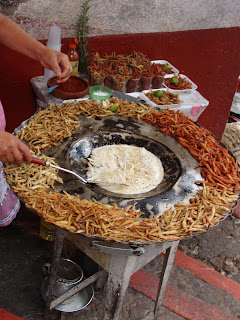
This really wasn´t even my meal. I had tacos. Alpastor and Bistec tacos. And they were delicious. No, this was the meal that my three companions shared. The picture doesn´t exactly capture exactly how large this meal is. I had it once before and its a real bargain. For $7 you can feel 3 or 4 people. Its tacos dorados (golden tacos aka friend rolled tacos). They are huge and there are nine of them. Together the three girls could only eat 6 and a half. Then there is chick, potatoes, lettuce, cheeses and other vegetables. Oily and delicious, this meal is huge.
However, the meal isn´t what this post is about. The meal is the condiment to the drink. Thick and of an off white color, behold the glorious Atole! Atole is , like everything else that lies in the heart of mexican cuisine, made of corn. Its sweet, kinda thick, but delicious. Well its not all sweet. There is a plain corn favor which is not so sweet. The sweet ones come in a variety of flavors including chocolate, canela, and guayaba. Its sold on the streets and occasionally restaurants. Always made fresh (I have not seen it bottled anywhere), it is a delicious treat to go with such meal that this post is not about.













